Sailfin pleco (Pterygoplichthys gibbiceps) is a kind of freshwater ray-finned fishes of Loricariidae family. This is a strong fish that eats huge amounts of algae. A couple of adult species can keep even large tanks clean. If a tank is rather large (of more than 70 gallons capacity) fish size can be up to 30-35 cm long.
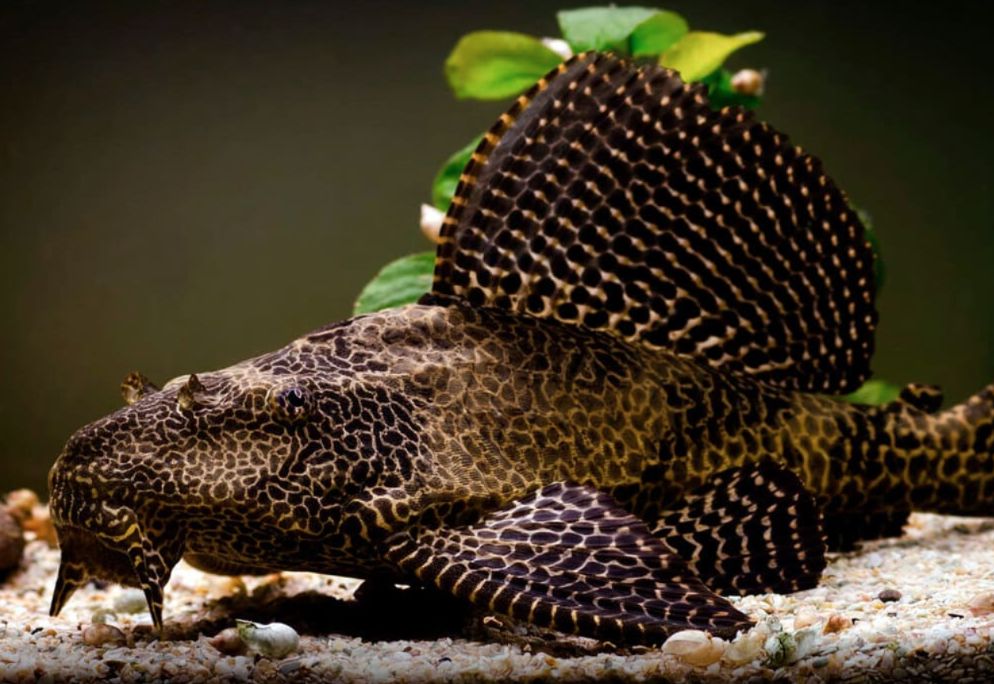
Contents
Habitat in the wild
The sailfin pleco belongs to the Loricariidae family, also known as the armored catfish family. Loricariidae is a large and diverse family of freshwater catfishes, commonly found in South America. These catfishes are well-known for their unique appearance, which includes bony plates and spines covering their bodies to provide protection.
The sailfin pleco, scientifically known as Pterygoplichthys gibbiceps (previously classified as Glyptoperichthys gibbiceps), is one of the popular species within this family.
The sailfin pleco (Pterygoplichthys gibbiceps) is native to the Amazon River basin in South America. Peru and Brazil are sailfin pleco habitats. For example, this species was encountered in the Rio Pacaya river which has a slow water flow. Fish of this kind can form rather large groups to search food together. These catfishes are adapted to living in slow-moving or stagnant waters with plenty of vegetation and hiding spots.
In addition to their natural habitat in South America, sailfin plecos have been introduced to other parts of the world, primarily as aquarium pets. In some regions, they have become established in the wild, often due to accidental or intentional releases from aquariums. This has raised concerns about their potential impact on local ecosystems, as they can be prolific breeders and may outcompete native species in certain environments.
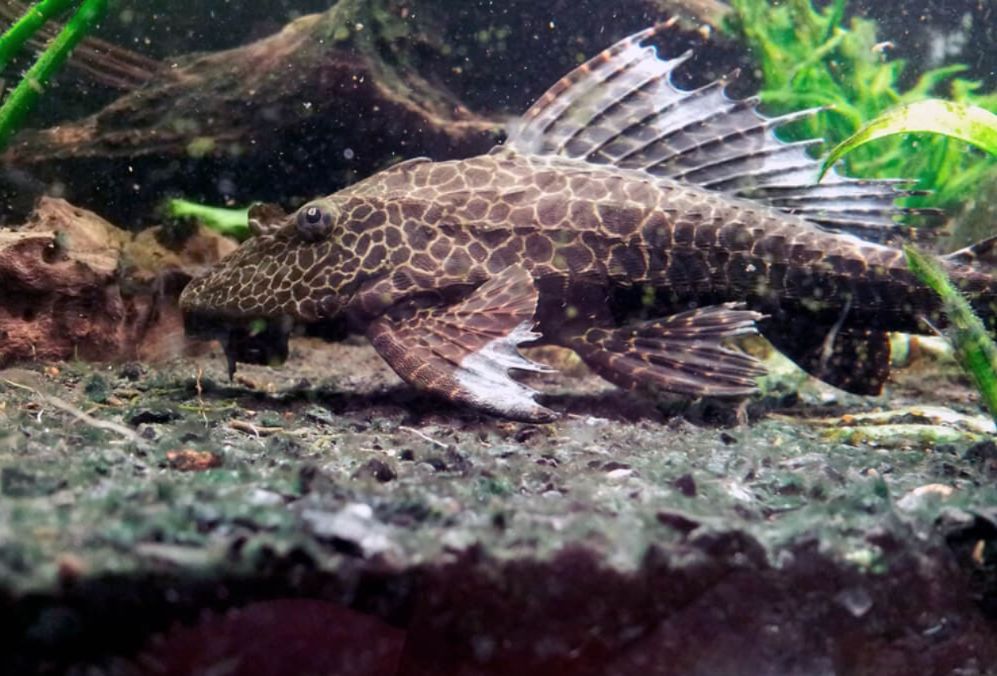
Description
Body
The sailfin pleco has a somewhat elongated and flattened body shape, typical of catfish species. Their bodies are covered in bony plates and spines, giving them an armored appearance for protection.
One of the most striking features of the sailfin pleco is its large, sail-like dorsal fin. This fin is positioned on the back of the fish and can be expanded or raised when the pleco feels threatened or wants to display dominance.
The coloration of the sailfin pleco can vary, but they are generally dark brown to black with light yellow or white spots covering their bodies. These spots can be irregular in shape and are spread throughout the body, creating an attractive pattern.
Like other plecos, sailfin plecos have a specialized mouth adapted for feeding on algae. They have a strong sucker-like mouth on their undersides, which they use to scrape algae off surfaces in their environment.
Size
The sailfin pleco is known for its impressive size, and it can grow quite large compared to many other aquarium fish. On average, adult sailfin plecos can reach a size of about 12 to 18 inches (30 to 45 centimeters) in length. However, in some cases, they may even grow larger, up to 2 feet (60 centimeters).
It’s important to consider their potential size when planning to keep sailfin plecos in an aquarium. Due to their large size, they require spacious tanks with plenty of room to swim and explore. A tank size of at least 75 gallons is recommended for a single sailfin pleco, and larger tanks or ponds are even better for providing an optimal environment for these fish.
Lifespan
The sailfin pleco typically has a lifespan of around 10 to 15 years in captivity. However, under optimal conditions with proper care, some individuals have been known to live even longer. The lifespan of any fish can be influenced by various factors, including water quality, diet, tank size, and overall health.
To help ensure the best possible lifespan for a sailfin pleco, it’s essential to provide a suitable and well-maintained aquarium environment with clean water, adequate space, and a balanced diet. Regular water changes, a varied diet, and monitoring for any signs of illness or stress are also important aspects of keeping these fish healthy and happy throughout their lives.
| Characteristic | Description |
|---|---|
| Scientific Name | Pterygoplichthys gibbiceps |
| Common Name | Sailfin Pleco; gibbiceps pleco; high fin spotted plecostomus; leopard sailfin pleco; leopard pleco |
| Family | Loricariidae |
| Origin | Amazon River basin (South America) |
| Size | Up to 18 inches (45 centimeters) |
| Lifespan | 10 to 15 years |
| Diet | Omnivorous (algae, vegetables, and some meaty foods) |
| Behavior | Nocturnal, peaceful, and shy |
| Tank Size | Large aquarium (at least 75 gallons) |
| Water Parameters | Temperature: 72-82°F (22-28°C) pH: 6.5-7.5 |
| Compatibility | Generally peaceful, but can be territorial with other bottom-dwelling fish |
| Tank Setup | Plenty of hiding places and driftwood; prefers well-oxygenated water |
| Breeding | Difficult to breed in captivity |
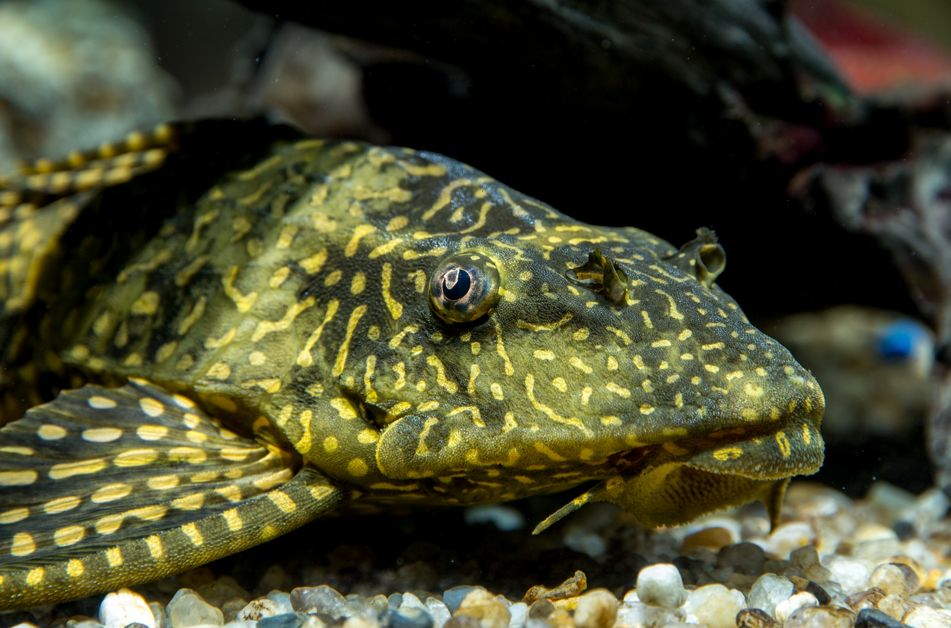
Care and keeping in a tank
Sailfin pleco is the fish just for beginners, but you have to keep how large is an adult fish, since quite often this species is being sold as a tank-cleaner. Beginners buy this fish for some small capacity tanks and some time later it becomes a problem.
Tank size
The sailfin pleco is a large fish that requires a spacious tank to thrive comfortably. Given its potential adult size of up to 18 inches (45 centimeters) and its active nature, a minimum tank size of 75 gallons (284 liters) is recommended for a single sailfin pleco.
However, it’s important to keep in mind that larger tanks are always better for this species. More space allows the fish to swim freely and reduces territorial behavior. Providing a larger tank also allows for better water quality and helps minimize stress on the fish, which contributes to its overall well-being and longevity.
Providing a larger tank, such as a 100-gallon or even larger setup, would give the fish more room to swim and explore, which can contribute to their overall well-being.
Additionally, it’s important to consider tank dimensions, as sailfin plecos are bottom-dwelling fish that require adequate space to move along the substrate. Providing plenty of hiding spots, caves, and driftwood is also essential to mimic their natural environment and cater to their behavior.
If you plan to keep multiple sailfin plecos or other fish species in the same tank, you’ll need to increase the tank size accordingly to accommodate their potential growth and minimize territorial conflicts.
Water parameters
Optimal temperature of tank water parameters is:
- Temperature: The ideal temperature range for sailfin plecos is between 72°F and 82°F (22°C to 28°C). Keeping the water within this range will ensure that the fish remain comfortable and active.
- pH Level: The pH level should be maintained between 6.5 and 7.5. This range provides a slightly acidic to neutral environment, which is suitable for most freshwater fish, including sailfin plecos.
- Ammonia, Nitrite, and Nitrate: Ammonia and nitrite levels should always be at zero in a well-established aquarium. These compounds are toxic to fish and can lead to health issues or even death if present in elevated concentrations. Regular water testing and water changes are essential to keep these levels in check. Nitrate levels should be kept below 40 ppm (parts per million), preferably lower.
- Hardness: Sailfin plecos are adaptable to a range of water hardness levels. A moderate hardness level, between 5 to 15 dGH (degrees of General Hardness), is generally suitable.
- Filtration and Aeration: Proper filtration is crucial for maintaining water quality and removing waste products. A strong and efficient filtration system, along with regular water changes, will help keep the water clean and clear.It’s not necessary to keep high level of oxygen in a tank water when keeping sailfin pleco in a tank. In case of having hypoxic water in a tank pleco comes up to the water surface more often and swallows some air that is then accumulated in its bowel. Oxygen can come through the gut walls and provide the fish with required amount of oxygen.
- Chlorine and Chloramine: Before adding tap water to the aquarium, always treat it with a water conditioner that neutralizes chlorine and chloramine. These chemicals can harm fish and should be removed from the water before introducing it to the tank.
Remember to perform regular water testing to monitor the water parameters and make adjustments as needed. Sailfin plecos are generally hardy, but sudden fluctuations or prolonged exposure to poor water conditions can stress them and make them susceptible to diseases.
Substrate
The substrate for a sailfin pleco aquarium should be chosen carefully to provide a suitable environment for the fish and support their natural behaviors. Here are some substrate options that work well for a sailfin pleco tank:
- Fine Sand: Fine sand is an excellent substrate choice for sailfin plecos. It allows them to exhibit their natural foraging behavior by sifting through the sand in search of food and algae. Sand is also gentle on their delicate undersides and won’t damage their barbels.
- Smooth Gravel: If you prefer gravel over sand, choose smooth, rounded gravel to avoid sharp edges that could potentially harm the pleco’s soft underbelly.
- Bare Bottom: Some aquarists opt for a bare-bottom tank for easier maintenance and cleaning. While this may be a practical choice, it doesn’t offer the same natural foraging opportunities as a substrate with sand or gravel.
Regardless of the substrate type, it’s essential to avoid using sharp or jagged materials that could injure the pleco or hinder their movement along the tank bottom. Also, ensure that the substrate is thoroughly cleaned before adding it to the tank to prevent any potential contaminants.
Decor
Creating a suitable and enriching environment for your sailfin pleco is essential for their well-being and happiness. Here are some decor elements you can consider adding to their tank:
- Driftwood: Sailfin plecos are known to graze on driftwood, which helps with their digestion and provides essential nutrients. Absence of snags in a tank may lead to the fish indigestion. Moreover, driftwood creates natural hiding spots and adds to the aesthetics of the tank.
- Caves and Hiding Places: As nocturnal and shy fish, sailfin plecos appreciate having caves or other hiding spots to retreat to during the day. You can use ceramic caves, PVC pipes, or coconut shells to create these hiding places.
- Smooth Rocks: Smooth river rocks can be added to the tank to mimic their natural habitat. Avoid sharp or rough rocks that might harm their delicate barbels or damage their armored bodies.
Remember to regularly clean and maintain the decor elements and the tank itself to ensure a healthy and thriving environment for your sailfin pleco. Providing a well-designed and enriching habitat will not only benefit their physical health but also allow them to exhibit natural behaviors and reduce stress.
Tank mates
Sailfin pleco is quite peaceful towards any other fish (can live with such aggressive fishes as large cichlids like oscar, jaguar cichlid, green terror and flowerhorn) , but there may be some fights as for the territory with some other catfish.
In a small and crowded tank gibbiceps pleco may become quite aggressive and attack other fish when protecting its territory. But it can live with such aggressive fish as oscar and african or american cichlids.
Pay attention, though sailfin pleco feeds mainly on plant food, in the wild the catfish are also scavengers. In a tank pleco may bite off some scales from discuses and angelfish at night, therefore it’s not a good idea to keep in a tank together with some flat from sides and slow fish.
Is more active at night and during the day the fish usually hides in some covers in a tank.
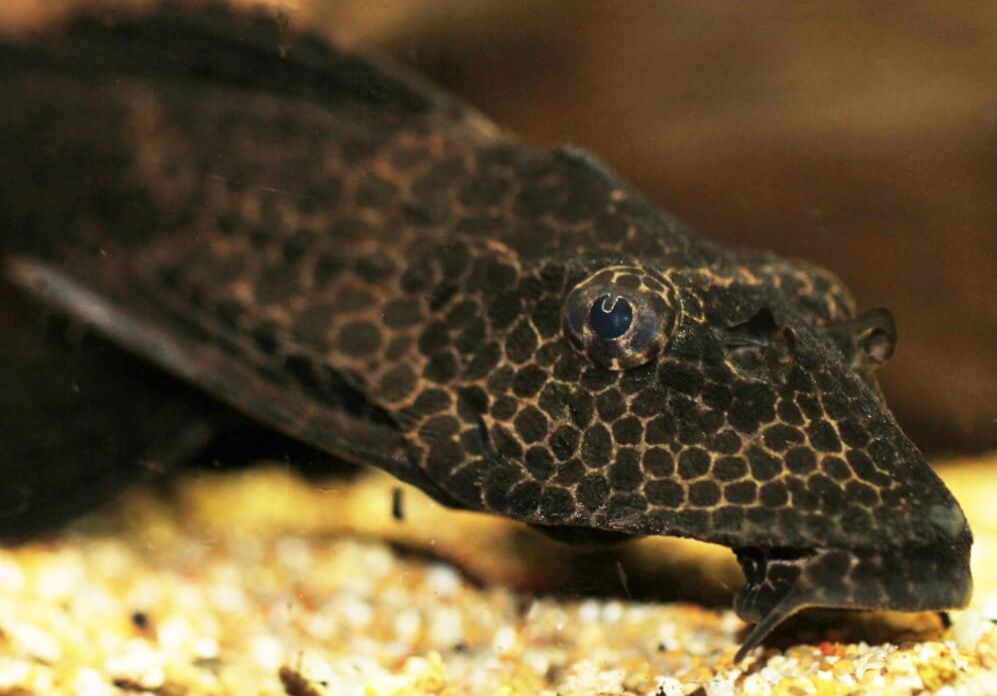
Diet
Sailfin plecos are omnivorous fish with a natural diet that primarily consists of algae, plant matter, and some meaty foods. As aquarium pets, their diet can be quite diverse to ensure they receive proper nutrition.
Here’s a list of suitable foods for sailfin plecos:
- Algae: One of the primary components of their diet is algae. They will graze on algae that naturally grow in the aquarium, including diatoms, green algae, and brown algae. Having algae-covered surfaces in the tank is beneficial for their well-being.
- Algae Wafers/Pellets: To supplement the natural algae in the tank, you can offer high-quality algae wafers or pellets. These specially formulated foods are designed to meet the dietary needs of algae-eating fish like plecos.
- Vegetables: It’s important to feed gibbiceps pleco with a variety of plant food. An ideal plant-protein ratio for the fish diet is 80% of plant and 20% of protein containing food. Spinach, carrots, cucumbers and squash will do as food. Nowadays there is a large amount of some specialized feed for catfish, which is rather balanced and it can be used as a basis of the diet and it can be combined with some plant additions.
- Meaty Foods: Although their primary diet consists of plant matter, sailfin plecos will also consume some meaty foods. It’s better to use frozen live feed, as a rule gibbiceps pleco picks it from a tank bottom after some other fishes have been fed. It’s preferable to feed the fish with prawns, worms and blood worms as a life feed representatives. Prawns should be cut into small pieces for the juveniles and it’s ok to feed adult fish with whole prawns.
- Driftwood and Supplements: Providing driftwood in the aquarium is essential for sailfin plecos. The wood not only serves as a hiding spot but also acts as a natural food source. Plecos will rasp on the wood’s surface, ingesting small wood particles that aid in their digestion. Additionally, consider providing mineral-rich supplements to support their overall health.
- Avoid overfeeding: Sailfin plecos have a slow metabolism, so it’s important not to overfeed them. Excess food can lead to poor water quality and contribute to obesity, which may result in health problems.
As with any fish, it’s essential to provide a balanced diet to meet their nutritional needs. Observe their eating habits and adjust the diet accordingly to ensure they stay healthy and thrive in their environment.
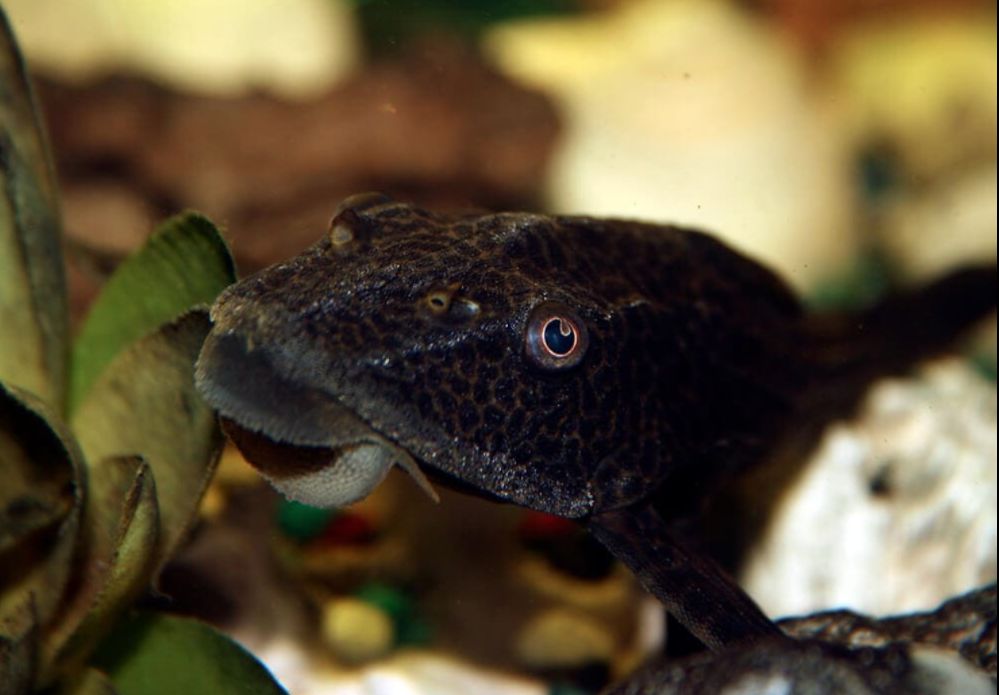
Gender differences: male vs female
It’s quite difficult to see difference between sailfin pleco male and female. There are no distinct external physical differences between males and females, making it difficult to determine their sex by visual inspection alone.
However, as they mature, some slight differences may become apparent, but these are not always reliable indicators. In some cases, experienced hobbyists and breeders might be able to identify potential differences based on behavioral observations or subtle physical characteristics, but it’s not a guaranteed method.
For more accurate sex determination, you would typically need to examine the fish’s reproductive organs internally, which requires dissection or specialized techniques, making it impractical for most aquarium owners.
In general, unless you are specifically trying to breed sailfin plecos, knowing their sex is not crucial for their care. It’s more important to focus on providing them with a suitable environment, proper nutrition, and regular maintenance to ensure their well-being and longevity. If you suspect you have a pair and wish to breed them, seeking advice from experienced breeders or aquarists would be beneficial.
Breeding
Breeding is impossible in a tank. The species you buy on the market were bred in the farms. The thing is, that in the wild for breeding the sailfin pleco requires some deep tunnels dug in the shore mud. The males stay in these tunnels after breeding and guard juveniles. In the farms they put fish into the large sized ponds with soft bottom.